Management in Practice 2: Spic and Span Environment Analysis Report
VerifiedAdded on 2022/08/12
|19
|4497
|34
Report
AI Summary
This report examines the external and internal environments impacting Spic and Span, a social enterprise aiming to transition from a cleaning company to a cleaning tech company. The analysis begins with an introduction to social enterprises and the challenges Spic and Span faces, particularly concerning its workforce of older and disabled employees. The external environment is assessed using PESTEL and VUCA analyses, highlighting political, economic, socio-cultural, technological, environmental, and legal factors, and their volatility, uncertainty, complexity, and ambiguity. Porter's Five Forces are then applied to analyze the industry's competitive landscape, focusing on the threat of new entrants, rivalry of competitors, threat of substitutes, and the power of buyers and suppliers. Internal factors are examined through resource and capability analysis, including VRIO framework. The report concludes with a SWOT analysis, summarizing the company's strengths, weaknesses, opportunities, and threats, and offering strategic insights for Spic and Span's successful transition. The report uses the provided assignment brief to structure the analysis.
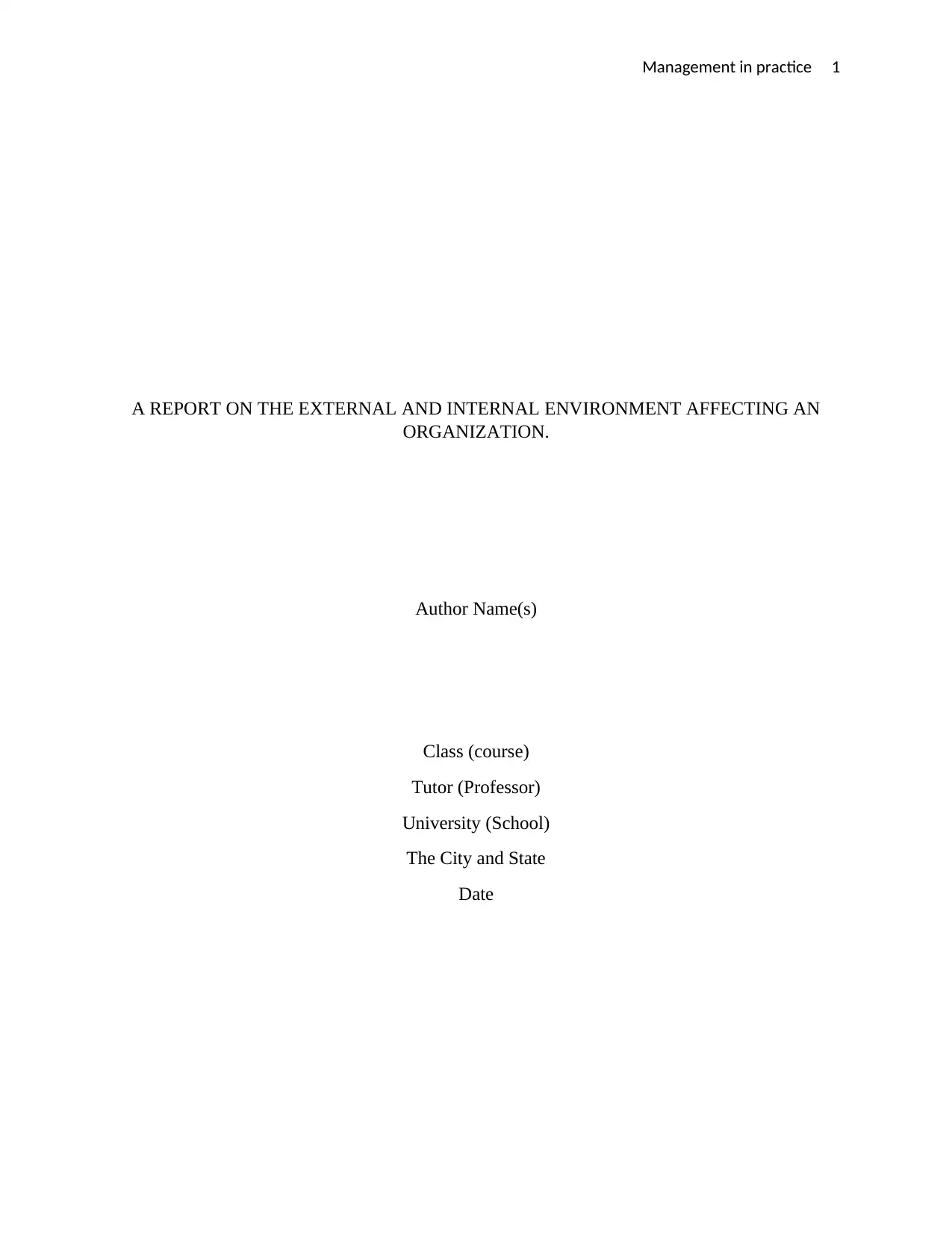
Management in practice 1
A REPORT ON THE EXTERNAL AND INTERNAL ENVIRONMENT AFFECTING AN
ORGANIZATION.
Author Name(s)
Class (course)
Tutor (Professor)
University (School)
The City and State
Date
A REPORT ON THE EXTERNAL AND INTERNAL ENVIRONMENT AFFECTING AN
ORGANIZATION.
Author Name(s)
Class (course)
Tutor (Professor)
University (School)
The City and State
Date
Paraphrase This Document
Need a fresh take? Get an instant paraphrase of this document with our AI Paraphraser
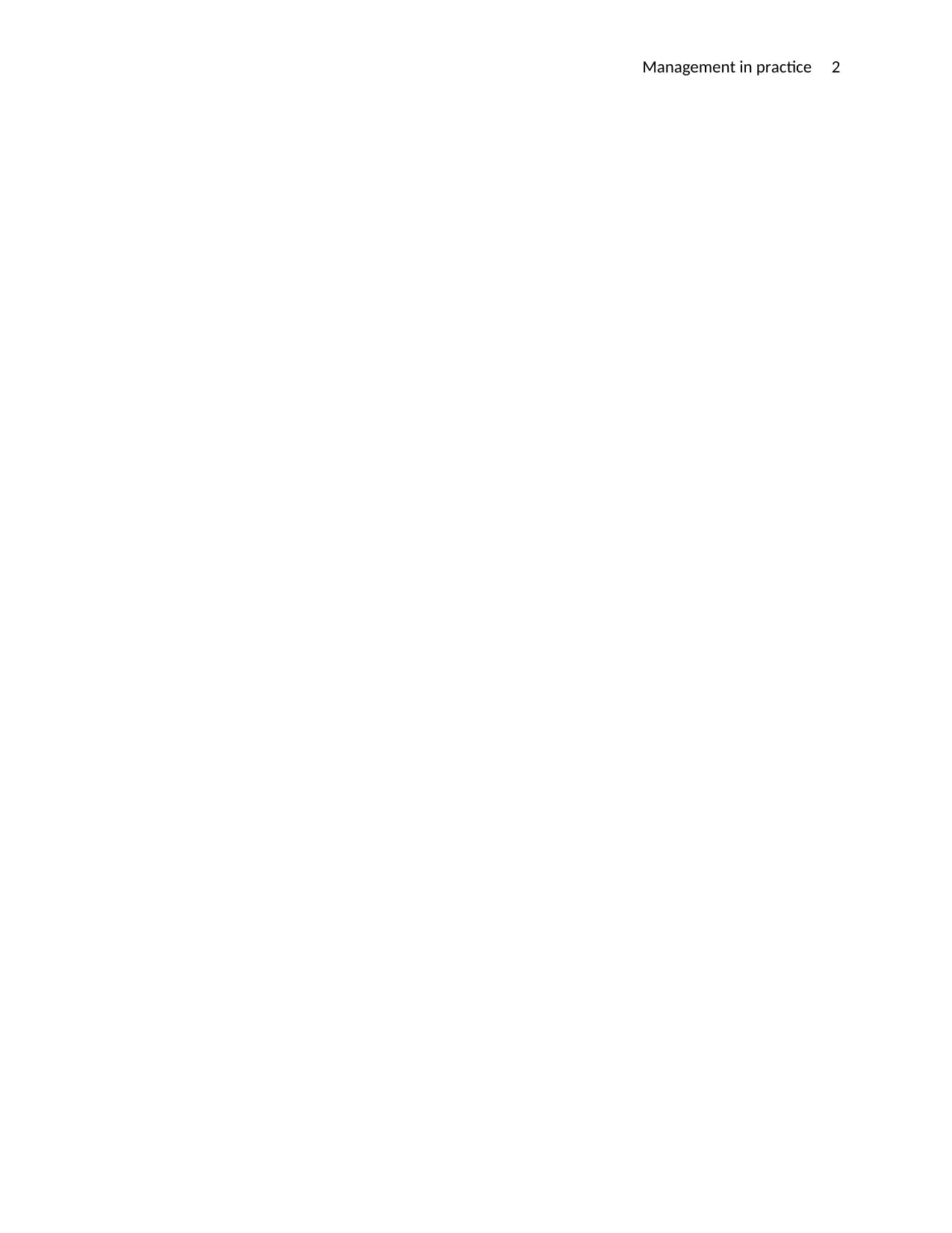
Management in practice 2
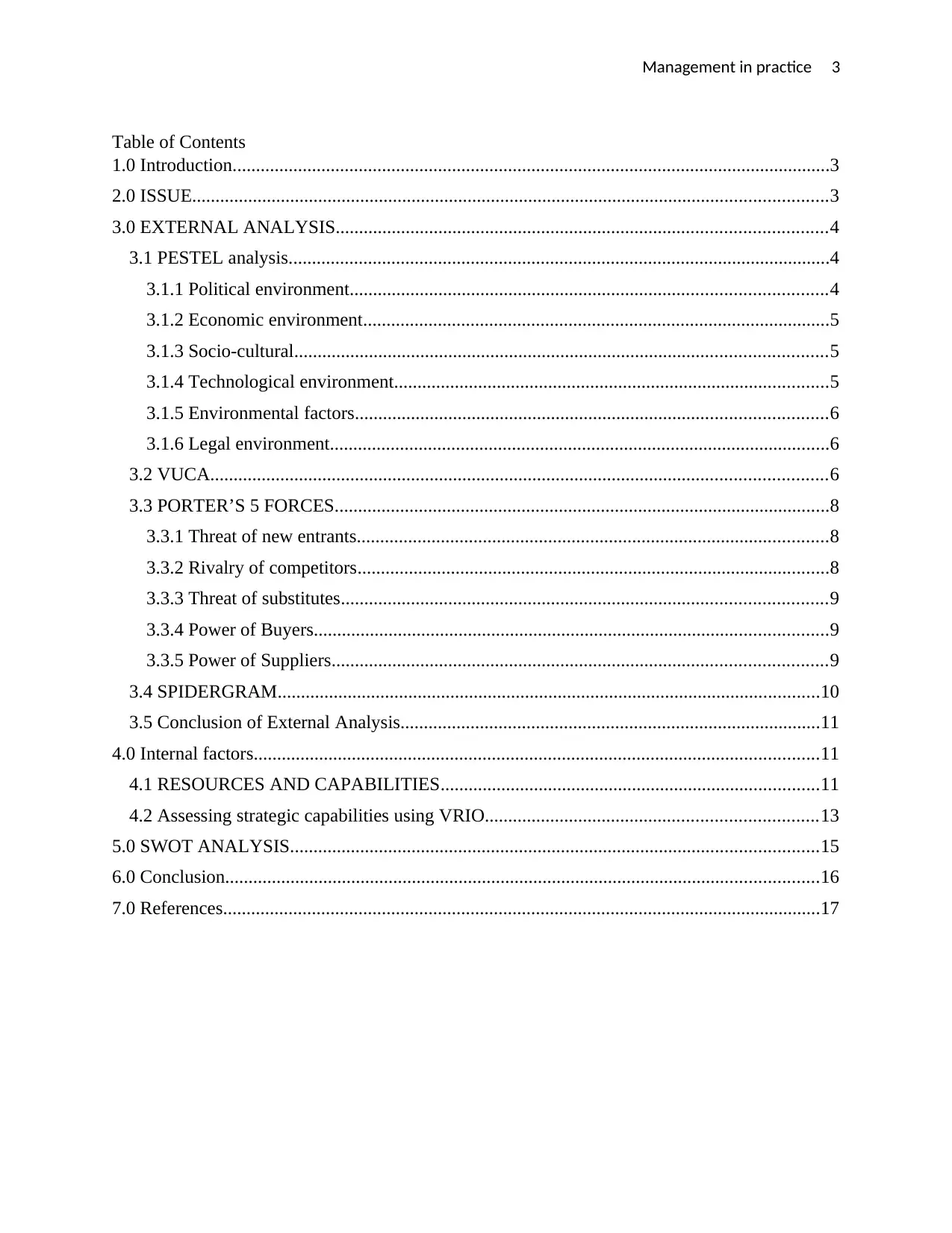
Management in practice 3
Table of Contents
1.0 Introduction................................................................................................................................3
2.0 ISSUE........................................................................................................................................3
3.0 EXTERNAL ANALYSIS.........................................................................................................4
3.1 PESTEL analysis....................................................................................................................4
3.1.1 Political environment......................................................................................................4
3.1.2 Economic environment....................................................................................................5
3.1.3 Socio-cultural..................................................................................................................5
3.1.4 Technological environment.............................................................................................5
3.1.5 Environmental factors.....................................................................................................6
3.1.6 Legal environment...........................................................................................................6
3.2 VUCA....................................................................................................................................6
3.3 PORTER’S 5 FORCES..........................................................................................................8
3.3.1 Threat of new entrants.....................................................................................................8
3.3.2 Rivalry of competitors.....................................................................................................8
3.3.3 Threat of substitutes........................................................................................................9
3.3.4 Power of Buyers..............................................................................................................9
3.3.5 Power of Suppliers..........................................................................................................9
3.4 SPIDERGRAM....................................................................................................................10
3.5 Conclusion of External Analysis..........................................................................................11
4.0 Internal factors.........................................................................................................................11
4.1 RESOURCES AND CAPABILITIES.................................................................................11
4.2 Assessing strategic capabilities using VRIO.......................................................................13
5.0 SWOT ANALYSIS.................................................................................................................15
6.0 Conclusion...............................................................................................................................16
7.0 References................................................................................................................................17
Table of Contents
1.0 Introduction................................................................................................................................3
2.0 ISSUE........................................................................................................................................3
3.0 EXTERNAL ANALYSIS.........................................................................................................4
3.1 PESTEL analysis....................................................................................................................4
3.1.1 Political environment......................................................................................................4
3.1.2 Economic environment....................................................................................................5
3.1.3 Socio-cultural..................................................................................................................5
3.1.4 Technological environment.............................................................................................5
3.1.5 Environmental factors.....................................................................................................6
3.1.6 Legal environment...........................................................................................................6
3.2 VUCA....................................................................................................................................6
3.3 PORTER’S 5 FORCES..........................................................................................................8
3.3.1 Threat of new entrants.....................................................................................................8
3.3.2 Rivalry of competitors.....................................................................................................8
3.3.3 Threat of substitutes........................................................................................................9
3.3.4 Power of Buyers..............................................................................................................9
3.3.5 Power of Suppliers..........................................................................................................9
3.4 SPIDERGRAM....................................................................................................................10
3.5 Conclusion of External Analysis..........................................................................................11
4.0 Internal factors.........................................................................................................................11
4.1 RESOURCES AND CAPABILITIES.................................................................................11
4.2 Assessing strategic capabilities using VRIO.......................................................................13
5.0 SWOT ANALYSIS.................................................................................................................15
6.0 Conclusion...............................................................................................................................16
7.0 References................................................................................................................................17
⊘ This is a preview!⊘
Do you want full access?
Subscribe today to unlock all pages.

Trusted by 1+ million students worldwide
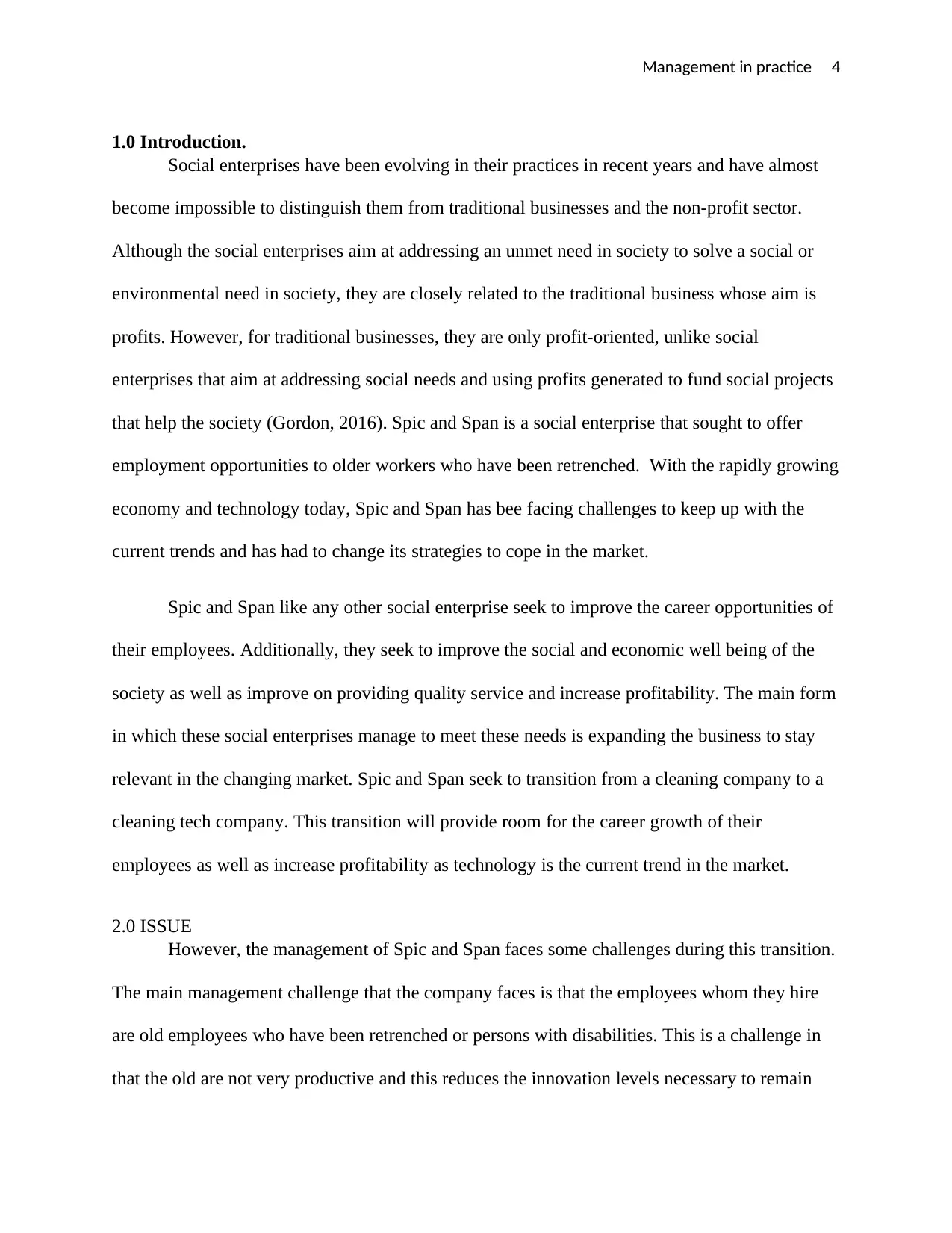
Management in practice 4
1.0 Introduction.
Social enterprises have been evolving in their practices in recent years and have almost
become impossible to distinguish them from traditional businesses and the non-profit sector.
Although the social enterprises aim at addressing an unmet need in society to solve a social or
environmental need in society, they are closely related to the traditional business whose aim is
profits. However, for traditional businesses, they are only profit-oriented, unlike social
enterprises that aim at addressing social needs and using profits generated to fund social projects
that help the society (Gordon, 2016). Spic and Span is a social enterprise that sought to offer
employment opportunities to older workers who have been retrenched. With the rapidly growing
economy and technology today, Spic and Span has bee facing challenges to keep up with the
current trends and has had to change its strategies to cope in the market.
Spic and Span like any other social enterprise seek to improve the career opportunities of
their employees. Additionally, they seek to improve the social and economic well being of the
society as well as improve on providing quality service and increase profitability. The main form
in which these social enterprises manage to meet these needs is expanding the business to stay
relevant in the changing market. Spic and Span seek to transition from a cleaning company to a
cleaning tech company. This transition will provide room for the career growth of their
employees as well as increase profitability as technology is the current trend in the market.
2.0 ISSUE
However, the management of Spic and Span faces some challenges during this transition.
The main management challenge that the company faces is that the employees whom they hire
are old employees who have been retrenched or persons with disabilities. This is a challenge in
that the old are not very productive and this reduces the innovation levels necessary to remain
1.0 Introduction.
Social enterprises have been evolving in their practices in recent years and have almost
become impossible to distinguish them from traditional businesses and the non-profit sector.
Although the social enterprises aim at addressing an unmet need in society to solve a social or
environmental need in society, they are closely related to the traditional business whose aim is
profits. However, for traditional businesses, they are only profit-oriented, unlike social
enterprises that aim at addressing social needs and using profits generated to fund social projects
that help the society (Gordon, 2016). Spic and Span is a social enterprise that sought to offer
employment opportunities to older workers who have been retrenched. With the rapidly growing
economy and technology today, Spic and Span has bee facing challenges to keep up with the
current trends and has had to change its strategies to cope in the market.
Spic and Span like any other social enterprise seek to improve the career opportunities of
their employees. Additionally, they seek to improve the social and economic well being of the
society as well as improve on providing quality service and increase profitability. The main form
in which these social enterprises manage to meet these needs is expanding the business to stay
relevant in the changing market. Spic and Span seek to transition from a cleaning company to a
cleaning tech company. This transition will provide room for the career growth of their
employees as well as increase profitability as technology is the current trend in the market.
2.0 ISSUE
However, the management of Spic and Span faces some challenges during this transition.
The main management challenge that the company faces is that the employees whom they hire
are old employees who have been retrenched or persons with disabilities. This is a challenge in
that the old are not very productive and this reduces the innovation levels necessary to remain
Paraphrase This Document
Need a fresh take? Get an instant paraphrase of this document with our AI Paraphraser
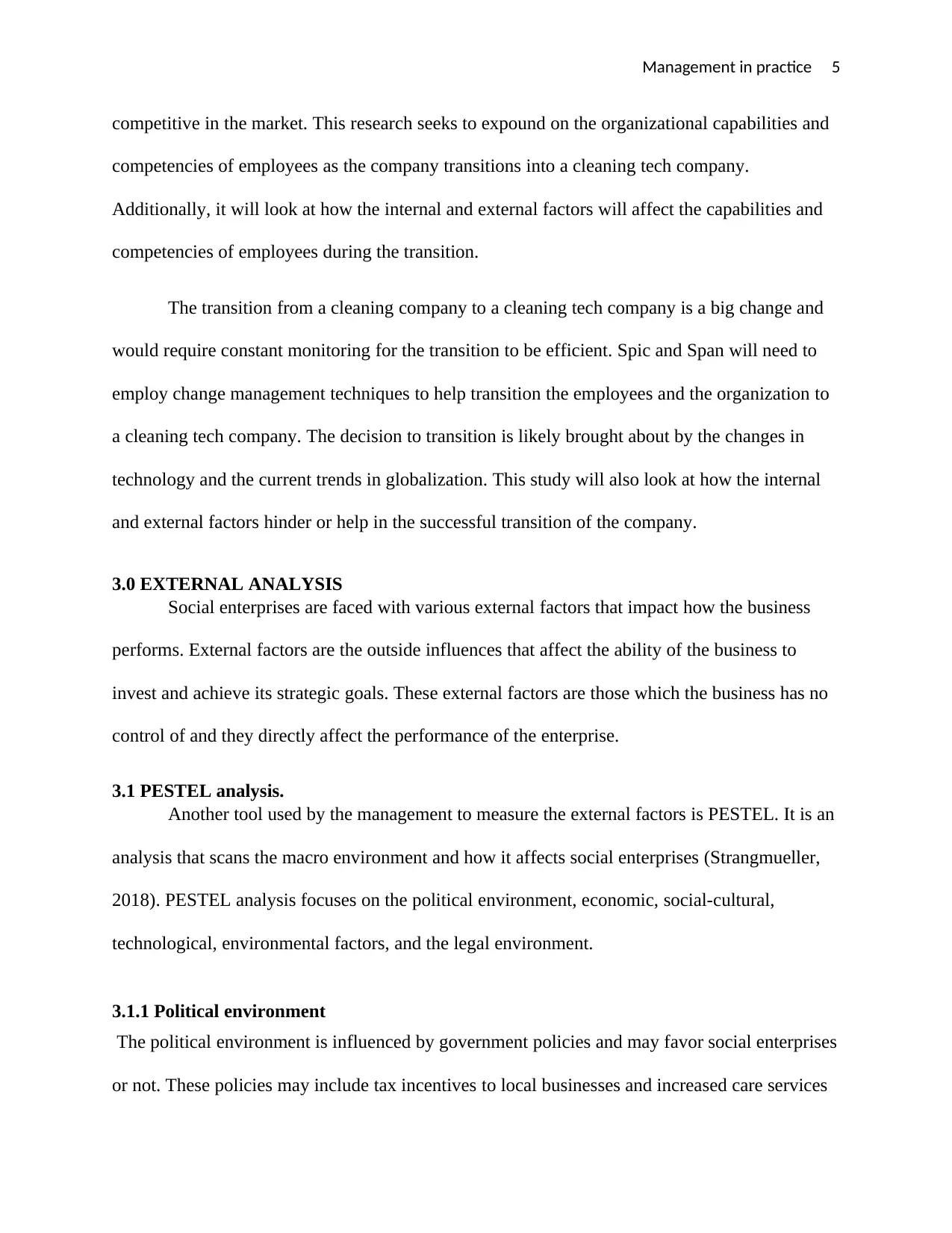
Management in practice 5
competitive in the market. This research seeks to expound on the organizational capabilities and
competencies of employees as the company transitions into a cleaning tech company.
Additionally, it will look at how the internal and external factors will affect the capabilities and
competencies of employees during the transition.
The transition from a cleaning company to a cleaning tech company is a big change and
would require constant monitoring for the transition to be efficient. Spic and Span will need to
employ change management techniques to help transition the employees and the organization to
a cleaning tech company. The decision to transition is likely brought about by the changes in
technology and the current trends in globalization. This study will also look at how the internal
and external factors hinder or help in the successful transition of the company.
3.0 EXTERNAL ANALYSIS
Social enterprises are faced with various external factors that impact how the business
performs. External factors are the outside influences that affect the ability of the business to
invest and achieve its strategic goals. These external factors are those which the business has no
control of and they directly affect the performance of the enterprise.
3.1 PESTEL analysis.
Another tool used by the management to measure the external factors is PESTEL. It is an
analysis that scans the macro environment and how it affects social enterprises (Strangmueller,
2018). PESTEL analysis focuses on the political environment, economic, social-cultural,
technological, environmental factors, and the legal environment.
3.1.1 Political environment
The political environment is influenced by government policies and may favor social enterprises
or not. These policies may include tax incentives to local businesses and increased care services
competitive in the market. This research seeks to expound on the organizational capabilities and
competencies of employees as the company transitions into a cleaning tech company.
Additionally, it will look at how the internal and external factors will affect the capabilities and
competencies of employees during the transition.
The transition from a cleaning company to a cleaning tech company is a big change and
would require constant monitoring for the transition to be efficient. Spic and Span will need to
employ change management techniques to help transition the employees and the organization to
a cleaning tech company. The decision to transition is likely brought about by the changes in
technology and the current trends in globalization. This study will also look at how the internal
and external factors hinder or help in the successful transition of the company.
3.0 EXTERNAL ANALYSIS
Social enterprises are faced with various external factors that impact how the business
performs. External factors are the outside influences that affect the ability of the business to
invest and achieve its strategic goals. These external factors are those which the business has no
control of and they directly affect the performance of the enterprise.
3.1 PESTEL analysis.
Another tool used by the management to measure the external factors is PESTEL. It is an
analysis that scans the macro environment and how it affects social enterprises (Strangmueller,
2018). PESTEL analysis focuses on the political environment, economic, social-cultural,
technological, environmental factors, and the legal environment.
3.1.1 Political environment
The political environment is influenced by government policies and may favor social enterprises
or not. These policies may include tax incentives to local businesses and increased care services
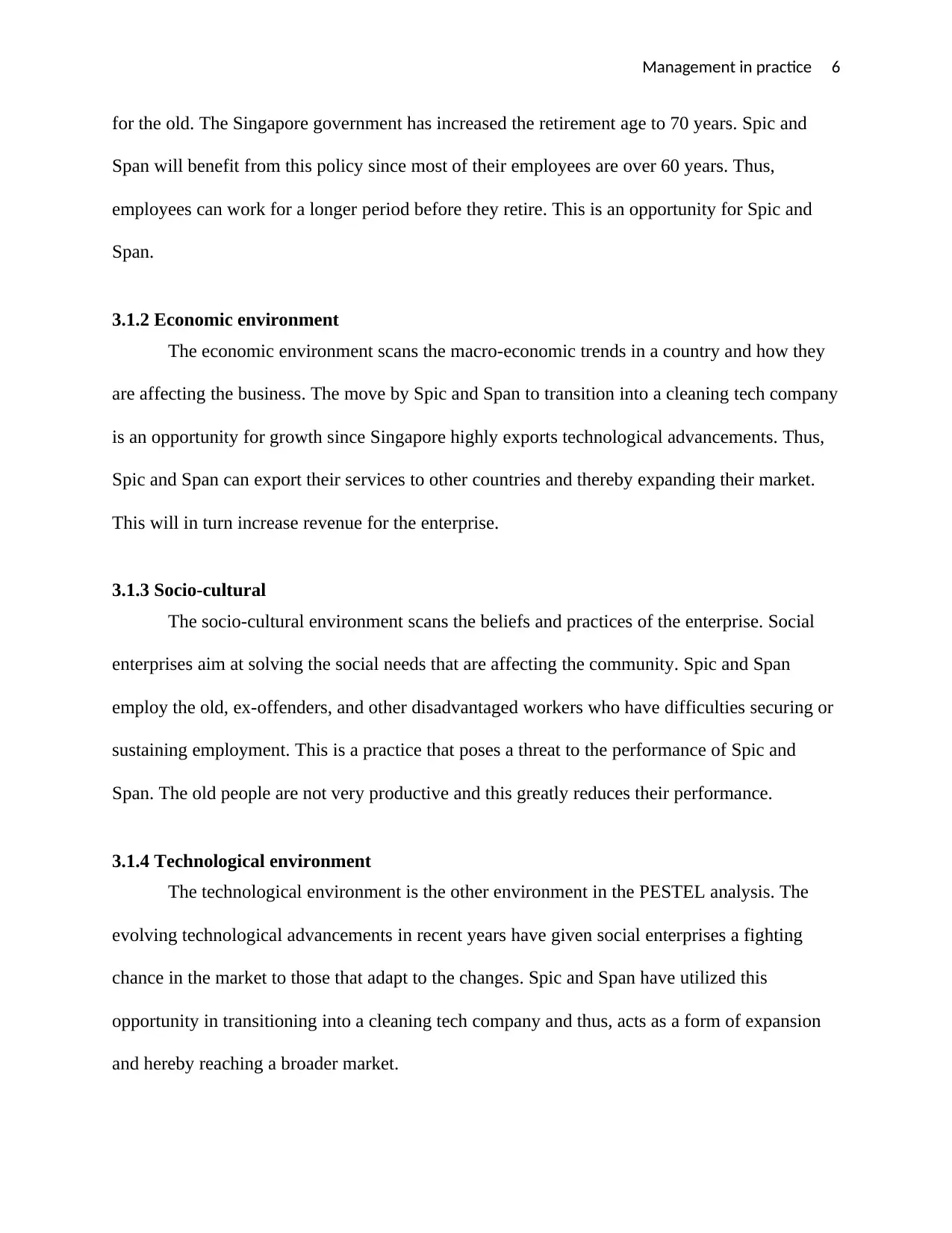
Management in practice 6
for the old. The Singapore government has increased the retirement age to 70 years. Spic and
Span will benefit from this policy since most of their employees are over 60 years. Thus,
employees can work for a longer period before they retire. This is an opportunity for Spic and
Span.
3.1.2 Economic environment
The economic environment scans the macro-economic trends in a country and how they
are affecting the business. The move by Spic and Span to transition into a cleaning tech company
is an opportunity for growth since Singapore highly exports technological advancements. Thus,
Spic and Span can export their services to other countries and thereby expanding their market.
This will in turn increase revenue for the enterprise.
3.1.3 Socio-cultural
The socio-cultural environment scans the beliefs and practices of the enterprise. Social
enterprises aim at solving the social needs that are affecting the community. Spic and Span
employ the old, ex-offenders, and other disadvantaged workers who have difficulties securing or
sustaining employment. This is a practice that poses a threat to the performance of Spic and
Span. The old people are not very productive and this greatly reduces their performance.
3.1.4 Technological environment
The technological environment is the other environment in the PESTEL analysis. The
evolving technological advancements in recent years have given social enterprises a fighting
chance in the market to those that adapt to the changes. Spic and Span have utilized this
opportunity in transitioning into a cleaning tech company and thus, acts as a form of expansion
and hereby reaching a broader market.
for the old. The Singapore government has increased the retirement age to 70 years. Spic and
Span will benefit from this policy since most of their employees are over 60 years. Thus,
employees can work for a longer period before they retire. This is an opportunity for Spic and
Span.
3.1.2 Economic environment
The economic environment scans the macro-economic trends in a country and how they
are affecting the business. The move by Spic and Span to transition into a cleaning tech company
is an opportunity for growth since Singapore highly exports technological advancements. Thus,
Spic and Span can export their services to other countries and thereby expanding their market.
This will in turn increase revenue for the enterprise.
3.1.3 Socio-cultural
The socio-cultural environment scans the beliefs and practices of the enterprise. Social
enterprises aim at solving the social needs that are affecting the community. Spic and Span
employ the old, ex-offenders, and other disadvantaged workers who have difficulties securing or
sustaining employment. This is a practice that poses a threat to the performance of Spic and
Span. The old people are not very productive and this greatly reduces their performance.
3.1.4 Technological environment
The technological environment is the other environment in the PESTEL analysis. The
evolving technological advancements in recent years have given social enterprises a fighting
chance in the market to those that adapt to the changes. Spic and Span have utilized this
opportunity in transitioning into a cleaning tech company and thus, acts as a form of expansion
and hereby reaching a broader market.
⊘ This is a preview!⊘
Do you want full access?
Subscribe today to unlock all pages.

Trusted by 1+ million students worldwide
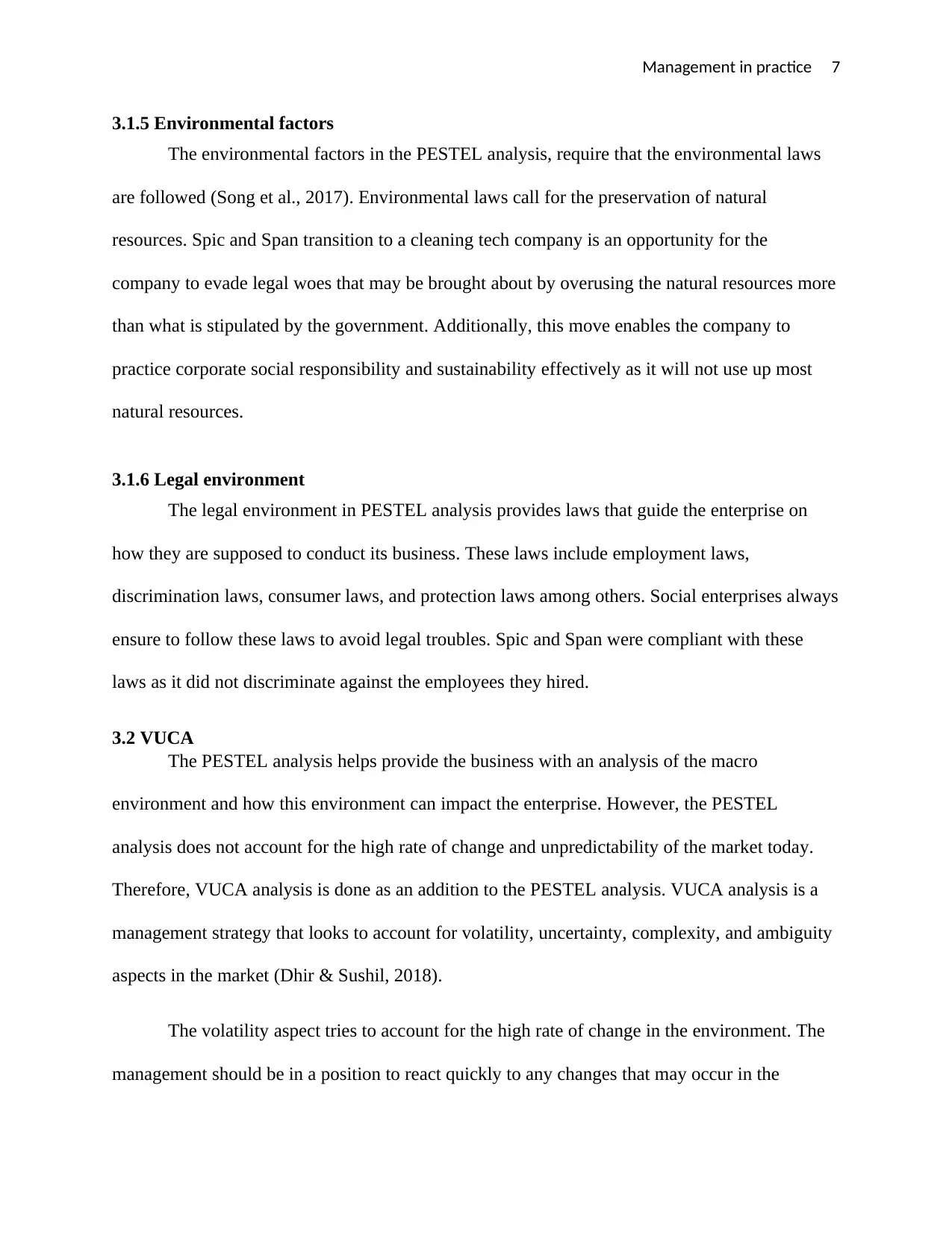
Management in practice 7
3.1.5 Environmental factors
The environmental factors in the PESTEL analysis, require that the environmental laws
are followed (Song et al., 2017). Environmental laws call for the preservation of natural
resources. Spic and Span transition to a cleaning tech company is an opportunity for the
company to evade legal woes that may be brought about by overusing the natural resources more
than what is stipulated by the government. Additionally, this move enables the company to
practice corporate social responsibility and sustainability effectively as it will not use up most
natural resources.
3.1.6 Legal environment
The legal environment in PESTEL analysis provides laws that guide the enterprise on
how they are supposed to conduct its business. These laws include employment laws,
discrimination laws, consumer laws, and protection laws among others. Social enterprises always
ensure to follow these laws to avoid legal troubles. Spic and Span were compliant with these
laws as it did not discriminate against the employees they hired.
3.2 VUCA
The PESTEL analysis helps provide the business with an analysis of the macro
environment and how this environment can impact the enterprise. However, the PESTEL
analysis does not account for the high rate of change and unpredictability of the market today.
Therefore, VUCA analysis is done as an addition to the PESTEL analysis. VUCA analysis is a
management strategy that looks to account for volatility, uncertainty, complexity, and ambiguity
aspects in the market (Dhir & Sushil, 2018).
The volatility aspect tries to account for the high rate of change in the environment. The
management should be in a position to react quickly to any changes that may occur in the
3.1.5 Environmental factors
The environmental factors in the PESTEL analysis, require that the environmental laws
are followed (Song et al., 2017). Environmental laws call for the preservation of natural
resources. Spic and Span transition to a cleaning tech company is an opportunity for the
company to evade legal woes that may be brought about by overusing the natural resources more
than what is stipulated by the government. Additionally, this move enables the company to
practice corporate social responsibility and sustainability effectively as it will not use up most
natural resources.
3.1.6 Legal environment
The legal environment in PESTEL analysis provides laws that guide the enterprise on
how they are supposed to conduct its business. These laws include employment laws,
discrimination laws, consumer laws, and protection laws among others. Social enterprises always
ensure to follow these laws to avoid legal troubles. Spic and Span were compliant with these
laws as it did not discriminate against the employees they hired.
3.2 VUCA
The PESTEL analysis helps provide the business with an analysis of the macro
environment and how this environment can impact the enterprise. However, the PESTEL
analysis does not account for the high rate of change and unpredictability of the market today.
Therefore, VUCA analysis is done as an addition to the PESTEL analysis. VUCA analysis is a
management strategy that looks to account for volatility, uncertainty, complexity, and ambiguity
aspects in the market (Dhir & Sushil, 2018).
The volatility aspect tries to account for the high rate of change in the environment. The
management should be in a position to react quickly to any changes that may occur in the
Paraphrase This Document
Need a fresh take? Get an instant paraphrase of this document with our AI Paraphraser
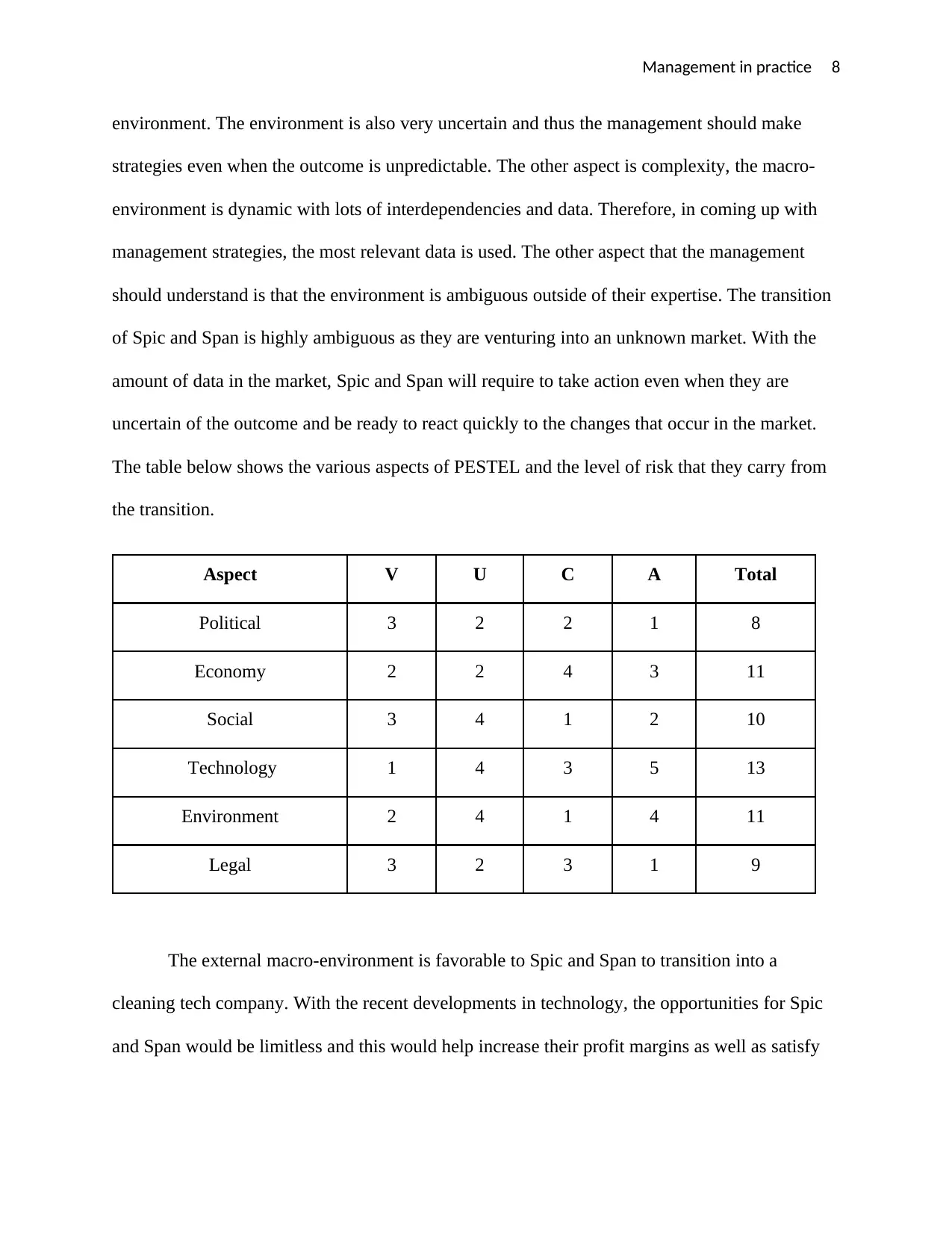
Management in practice 8
environment. The environment is also very uncertain and thus the management should make
strategies even when the outcome is unpredictable. The other aspect is complexity, the macro-
environment is dynamic with lots of interdependencies and data. Therefore, in coming up with
management strategies, the most relevant data is used. The other aspect that the management
should understand is that the environment is ambiguous outside of their expertise. The transition
of Spic and Span is highly ambiguous as they are venturing into an unknown market. With the
amount of data in the market, Spic and Span will require to take action even when they are
uncertain of the outcome and be ready to react quickly to the changes that occur in the market.
The table below shows the various aspects of PESTEL and the level of risk that they carry from
the transition.
Aspect V U C A Total
Political 3 2 2 1 8
Economy 2 2 4 3 11
Social 3 4 1 2 10
Technology 1 4 3 5 13
Environment 2 4 1 4 11
Legal 3 2 3 1 9
The external macro-environment is favorable to Spic and Span to transition into a
cleaning tech company. With the recent developments in technology, the opportunities for Spic
and Span would be limitless and this would help increase their profit margins as well as satisfy
environment. The environment is also very uncertain and thus the management should make
strategies even when the outcome is unpredictable. The other aspect is complexity, the macro-
environment is dynamic with lots of interdependencies and data. Therefore, in coming up with
management strategies, the most relevant data is used. The other aspect that the management
should understand is that the environment is ambiguous outside of their expertise. The transition
of Spic and Span is highly ambiguous as they are venturing into an unknown market. With the
amount of data in the market, Spic and Span will require to take action even when they are
uncertain of the outcome and be ready to react quickly to the changes that occur in the market.
The table below shows the various aspects of PESTEL and the level of risk that they carry from
the transition.
Aspect V U C A Total
Political 3 2 2 1 8
Economy 2 2 4 3 11
Social 3 4 1 2 10
Technology 1 4 3 5 13
Environment 2 4 1 4 11
Legal 3 2 3 1 9
The external macro-environment is favorable to Spic and Span to transition into a
cleaning tech company. With the recent developments in technology, the opportunities for Spic
and Span would be limitless and this would help increase their profit margins as well as satisfy
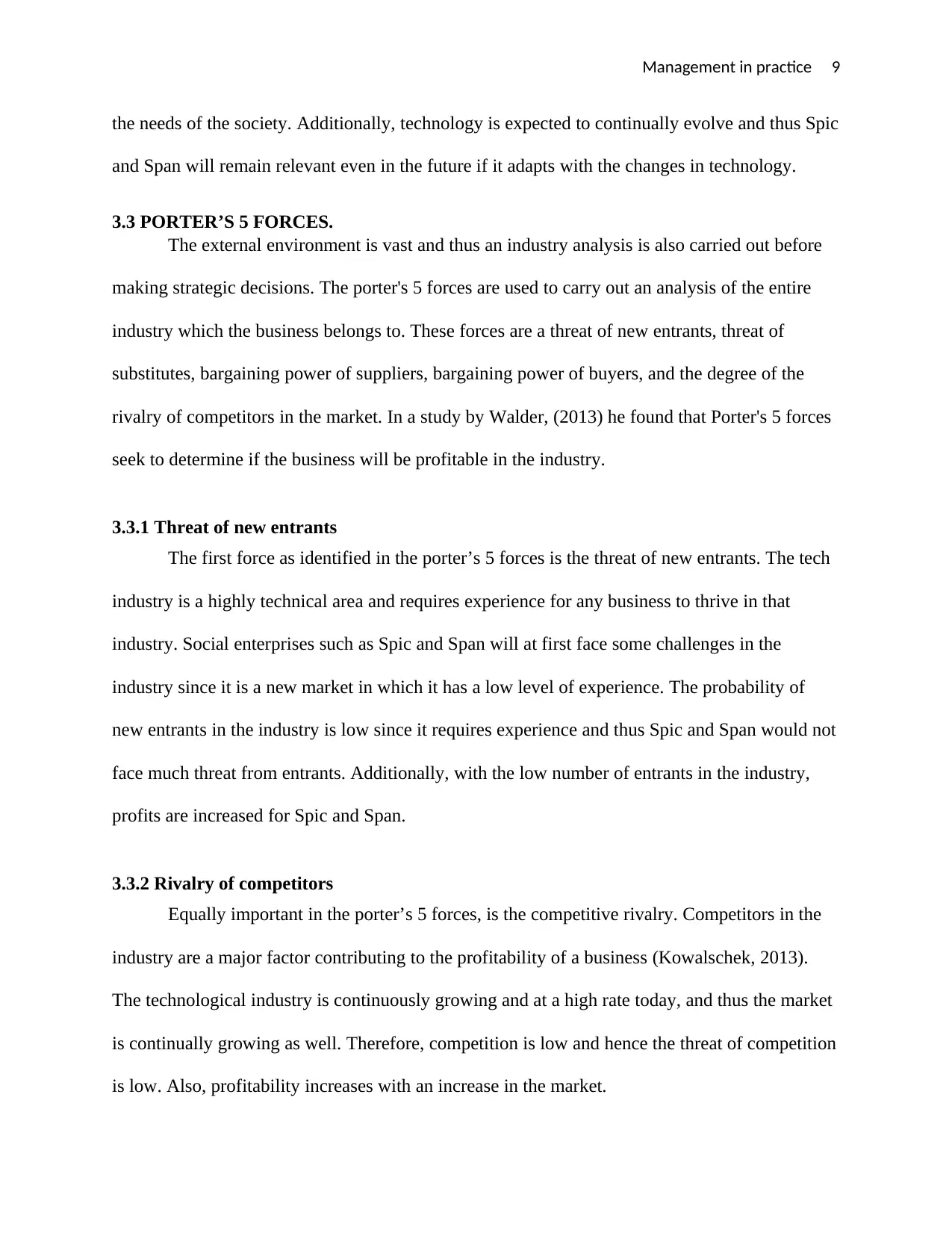
Management in practice 9
the needs of the society. Additionally, technology is expected to continually evolve and thus Spic
and Span will remain relevant even in the future if it adapts with the changes in technology.
3.3 PORTER’S 5 FORCES.
The external environment is vast and thus an industry analysis is also carried out before
making strategic decisions. The porter's 5 forces are used to carry out an analysis of the entire
industry which the business belongs to. These forces are a threat of new entrants, threat of
substitutes, bargaining power of suppliers, bargaining power of buyers, and the degree of the
rivalry of competitors in the market. In a study by Walder, (2013) he found that Porter's 5 forces
seek to determine if the business will be profitable in the industry.
3.3.1 Threat of new entrants
The first force as identified in the porter’s 5 forces is the threat of new entrants. The tech
industry is a highly technical area and requires experience for any business to thrive in that
industry. Social enterprises such as Spic and Span will at first face some challenges in the
industry since it is a new market in which it has a low level of experience. The probability of
new entrants in the industry is low since it requires experience and thus Spic and Span would not
face much threat from entrants. Additionally, with the low number of entrants in the industry,
profits are increased for Spic and Span.
3.3.2 Rivalry of competitors
Equally important in the porter’s 5 forces, is the competitive rivalry. Competitors in the
industry are a major factor contributing to the profitability of a business (Kowalschek, 2013).
The technological industry is continuously growing and at a high rate today, and thus the market
is continually growing as well. Therefore, competition is low and hence the threat of competition
is low. Also, profitability increases with an increase in the market.
the needs of the society. Additionally, technology is expected to continually evolve and thus Spic
and Span will remain relevant even in the future if it adapts with the changes in technology.
3.3 PORTER’S 5 FORCES.
The external environment is vast and thus an industry analysis is also carried out before
making strategic decisions. The porter's 5 forces are used to carry out an analysis of the entire
industry which the business belongs to. These forces are a threat of new entrants, threat of
substitutes, bargaining power of suppliers, bargaining power of buyers, and the degree of the
rivalry of competitors in the market. In a study by Walder, (2013) he found that Porter's 5 forces
seek to determine if the business will be profitable in the industry.
3.3.1 Threat of new entrants
The first force as identified in the porter’s 5 forces is the threat of new entrants. The tech
industry is a highly technical area and requires experience for any business to thrive in that
industry. Social enterprises such as Spic and Span will at first face some challenges in the
industry since it is a new market in which it has a low level of experience. The probability of
new entrants in the industry is low since it requires experience and thus Spic and Span would not
face much threat from entrants. Additionally, with the low number of entrants in the industry,
profits are increased for Spic and Span.
3.3.2 Rivalry of competitors
Equally important in the porter’s 5 forces, is the competitive rivalry. Competitors in the
industry are a major factor contributing to the profitability of a business (Kowalschek, 2013).
The technological industry is continuously growing and at a high rate today, and thus the market
is continually growing as well. Therefore, competition is low and hence the threat of competition
is low. Also, profitability increases with an increase in the market.
⊘ This is a preview!⊘
Do you want full access?
Subscribe today to unlock all pages.

Trusted by 1+ million students worldwide
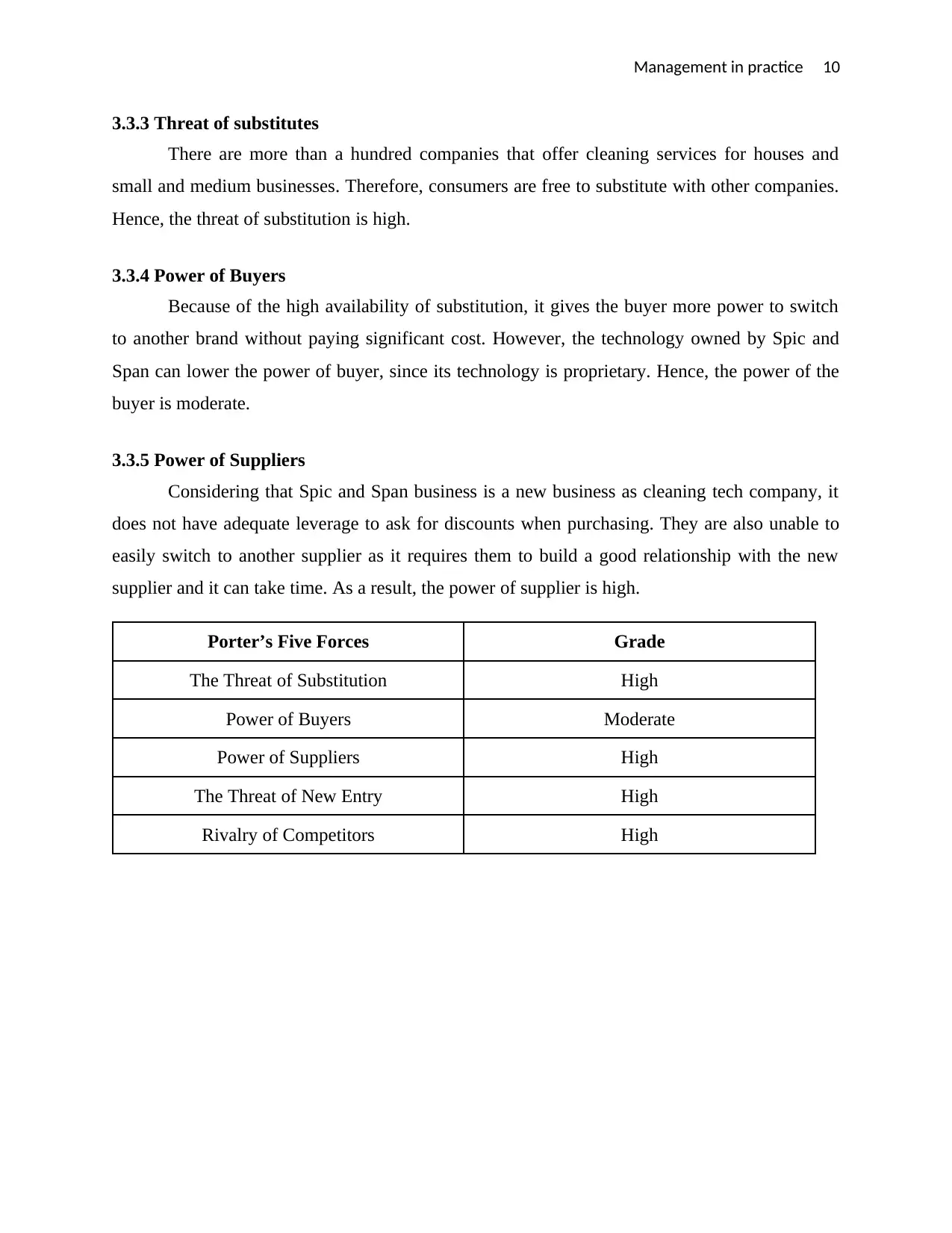
Management in practice 10
3.3.3 Threat of substitutes
There are more than a hundred companies that offer cleaning services for houses and
small and medium businesses. Therefore, consumers are free to substitute with other companies.
Hence, the threat of substitution is high.
3.3.4 Power of Buyers
Because of the high availability of substitution, it gives the buyer more power to switch
to another brand without paying significant cost. However, the technology owned by Spic and
Span can lower the power of buyer, since its technology is proprietary. Hence, the power of the
buyer is moderate.
3.3.5 Power of Suppliers
Considering that Spic and Span business is a new business as cleaning tech company, it
does not have adequate leverage to ask for discounts when purchasing. They are also unable to
easily switch to another supplier as it requires them to build a good relationship with the new
supplier and it can take time. As a result, the power of supplier is high.
Porter’s Five Forces Grade
The Threat of Substitution High
Power of Buyers Moderate
Power of Suppliers High
The Threat of New Entry High
Rivalry of Competitors High
3.3.3 Threat of substitutes
There are more than a hundred companies that offer cleaning services for houses and
small and medium businesses. Therefore, consumers are free to substitute with other companies.
Hence, the threat of substitution is high.
3.3.4 Power of Buyers
Because of the high availability of substitution, it gives the buyer more power to switch
to another brand without paying significant cost. However, the technology owned by Spic and
Span can lower the power of buyer, since its technology is proprietary. Hence, the power of the
buyer is moderate.
3.3.5 Power of Suppliers
Considering that Spic and Span business is a new business as cleaning tech company, it
does not have adequate leverage to ask for discounts when purchasing. They are also unable to
easily switch to another supplier as it requires them to build a good relationship with the new
supplier and it can take time. As a result, the power of supplier is high.
Porter’s Five Forces Grade
The Threat of Substitution High
Power of Buyers Moderate
Power of Suppliers High
The Threat of New Entry High
Rivalry of Competitors High
Paraphrase This Document
Need a fresh take? Get an instant paraphrase of this document with our AI Paraphraser
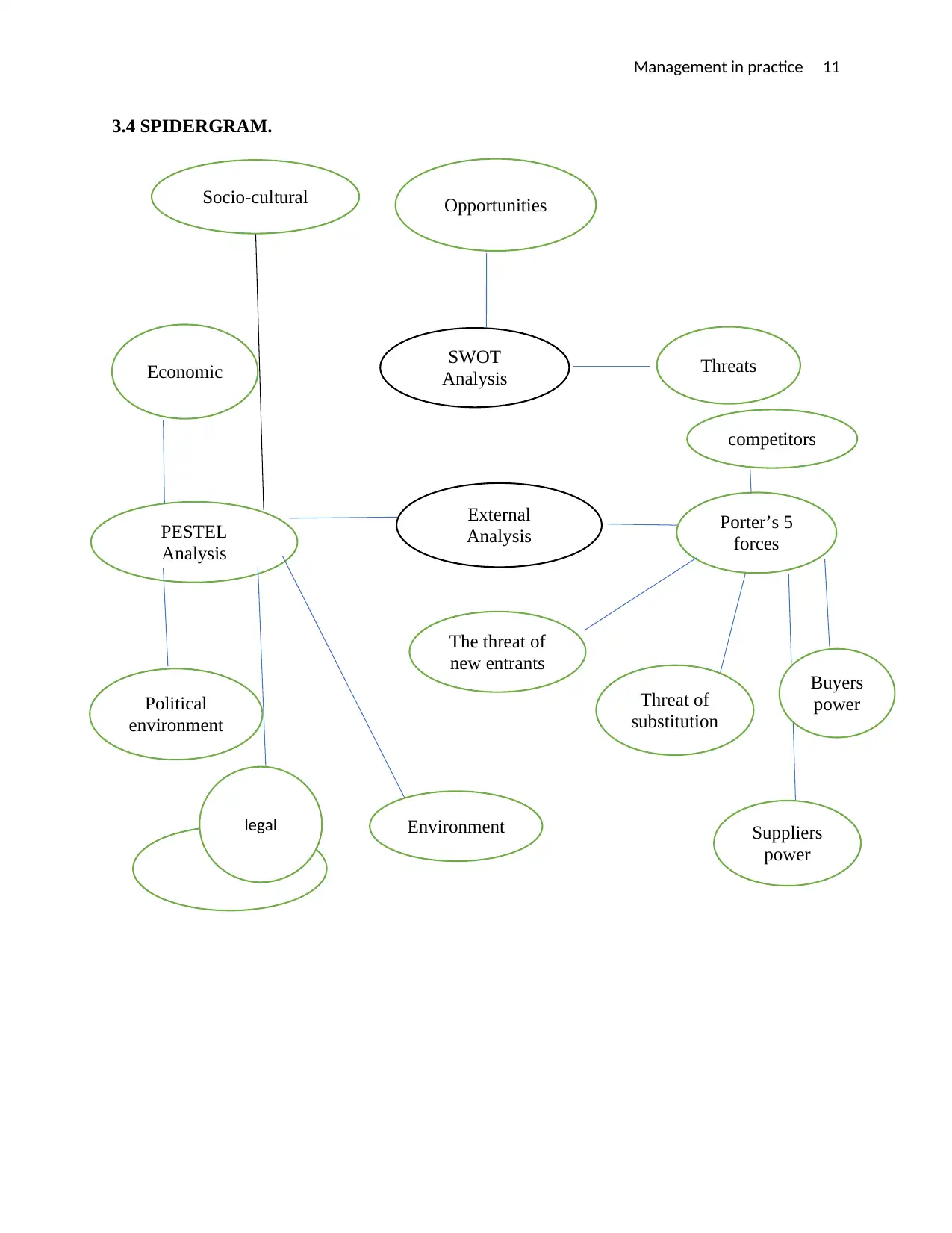
Management in practice 11
3.4 SPIDERGRAM.
SWOT
Analysis Threats
Opportunities
External
AnalysisPESTEL
Analysis
Political
environment
Economic
Socio-cultural
Environment
Porter’s 5
forces
The threat of
new entrants
Threat of
substitution
Suppliers
power
competitors
Buyers
power
legal
3.4 SPIDERGRAM.
SWOT
Analysis Threats
Opportunities
External
AnalysisPESTEL
Analysis
Political
environment
Economic
Socio-cultural
Environment
Porter’s 5
forces
The threat of
new entrants
Threat of
substitution
Suppliers
power
competitors
Buyers
power
legal
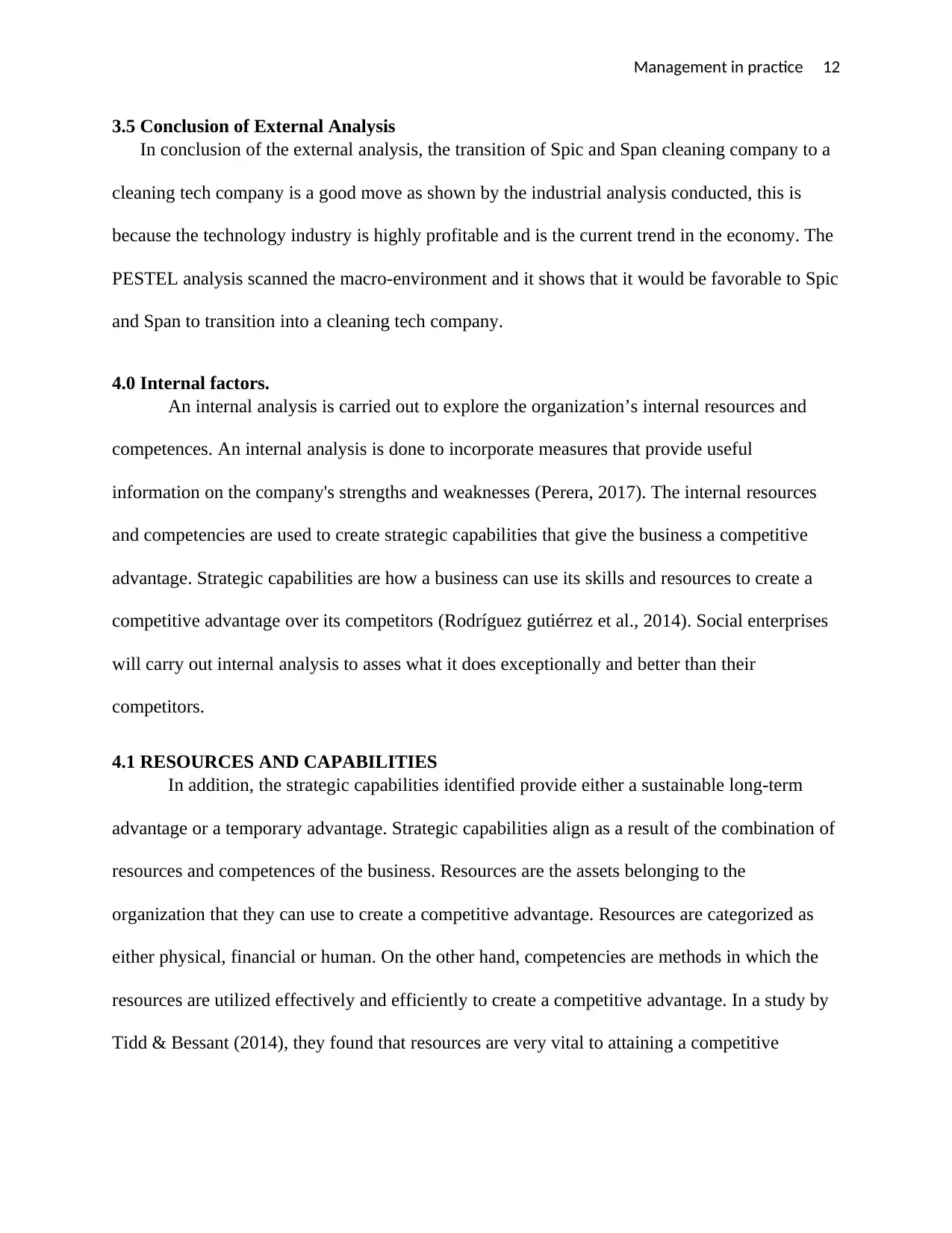
Management in practice 12
3.5 Conclusion of External Analysis
In conclusion of the external analysis, the transition of Spic and Span cleaning company to a
cleaning tech company is a good move as shown by the industrial analysis conducted, this is
because the technology industry is highly profitable and is the current trend in the economy. The
PESTEL analysis scanned the macro-environment and it shows that it would be favorable to Spic
and Span to transition into a cleaning tech company.
4.0 Internal factors.
An internal analysis is carried out to explore the organization’s internal resources and
competences. An internal analysis is done to incorporate measures that provide useful
information on the company's strengths and weaknesses (Perera, 2017). The internal resources
and competencies are used to create strategic capabilities that give the business a competitive
advantage. Strategic capabilities are how a business can use its skills and resources to create a
competitive advantage over its competitors (Rodríguez gutiérrez et al., 2014). Social enterprises
will carry out internal analysis to asses what it does exceptionally and better than their
competitors.
4.1 RESOURCES AND CAPABILITIES
In addition, the strategic capabilities identified provide either a sustainable long-term
advantage or a temporary advantage. Strategic capabilities align as a result of the combination of
resources and competences of the business. Resources are the assets belonging to the
organization that they can use to create a competitive advantage. Resources are categorized as
either physical, financial or human. On the other hand, competencies are methods in which the
resources are utilized effectively and efficiently to create a competitive advantage. In a study by
Tidd & Bessant (2014), they found that resources are very vital to attaining a competitive
3.5 Conclusion of External Analysis
In conclusion of the external analysis, the transition of Spic and Span cleaning company to a
cleaning tech company is a good move as shown by the industrial analysis conducted, this is
because the technology industry is highly profitable and is the current trend in the economy. The
PESTEL analysis scanned the macro-environment and it shows that it would be favorable to Spic
and Span to transition into a cleaning tech company.
4.0 Internal factors.
An internal analysis is carried out to explore the organization’s internal resources and
competences. An internal analysis is done to incorporate measures that provide useful
information on the company's strengths and weaknesses (Perera, 2017). The internal resources
and competencies are used to create strategic capabilities that give the business a competitive
advantage. Strategic capabilities are how a business can use its skills and resources to create a
competitive advantage over its competitors (Rodríguez gutiérrez et al., 2014). Social enterprises
will carry out internal analysis to asses what it does exceptionally and better than their
competitors.
4.1 RESOURCES AND CAPABILITIES
In addition, the strategic capabilities identified provide either a sustainable long-term
advantage or a temporary advantage. Strategic capabilities align as a result of the combination of
resources and competences of the business. Resources are the assets belonging to the
organization that they can use to create a competitive advantage. Resources are categorized as
either physical, financial or human. On the other hand, competencies are methods in which the
resources are utilized effectively and efficiently to create a competitive advantage. In a study by
Tidd & Bessant (2014), they found that resources are very vital to attaining a competitive
⊘ This is a preview!⊘
Do you want full access?
Subscribe today to unlock all pages.

Trusted by 1+ million students worldwide
1 out of 19
Related Documents
Your All-in-One AI-Powered Toolkit for Academic Success.
+13062052269
info@desklib.com
Available 24*7 on WhatsApp / Email
![[object Object]](/_next/static/media/star-bottom.7253800d.svg)
Unlock your academic potential
Copyright © 2020–2025 A2Z Services. All Rights Reserved. Developed and managed by ZUCOL.





